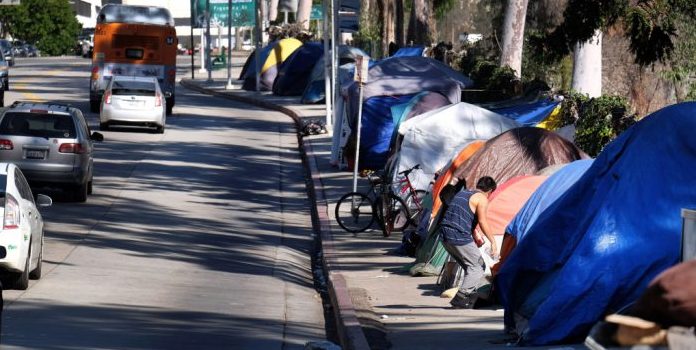Nearly 2,000 homeless people died in Los Angeles County during the first year of the pandemic, an increase of 56% from the previous year, driven mainly by drug overdoses, authorities said.
The findings released Friday in a report from the county’s Department of Public Health showed that despite initial fears, the virus itself was not the main culprit in deaths among California’s largest-in-the-nation unhoused population. But it did cut people off from mental health and substance abuse treatment after services were drastically reduced to prevent the spread of the virus.
Between April 1, 2020, and March 31, 2021, the county recorded 1,988 deaths of homeless people, up from 1,271 deaths during the same period a year earlier, the report said.
During both of those years, drug overdoses were the leading cause of death but increased by 78% during the pandemic’s first year. In the pre-pandemic year, the Department of Public Health reported 402 fatal overdoses. In the year after the outbreak, the number nearly doubled to 715, the report said.
The report found that 179 homeless people died from COVID-19 during the pandemic’s first year.
“The findings in this report reflect a true state of emergency,” said First District Supervisor Hilda L. Solis said in a statement. “In a civil society, it is unacceptable for any of us to not be profoundly disturbed by the shocking needs documented in this year’s homeless mortality report.”
A study of San Francisco homeless deaths released last month showed similar findings: Between March 2020 and March 2021, there were 331 homeless deaths recorded in San Francisco, more than twice the number of any previous year, with the leading cause of death being drug overdose, according to a study conducted by the University of California San Francisco and the city’s Department of Public Health.
Los Angeles County is home to the Skid Row neighborhood, notorious for poverty and drugs and where LA’s homeless population was once largely confined. Now, rows of tents, cardboard shelters, battered RVs and makeshift plywood structures are familiar sights throughout the nation’s second-most populous city.
Cities and states across the country are grappling with growing homelessness, as well as mental health crises. California has the largest unhoused population in the country, estimated at 161,000 with nearly a quarter of that number suffering from severe mental illness, according to a 2020 count of homeless people required by the U.S. Department of Housing and Urban Development.
The pandemic likely exacerbated an already growing drug and overdose problem, driven by the prevalence of fentanyl, authorities said. Methamphetamine was involved in the majority of deaths, at 75%, roughly the same as the previous year. But the involvement of fentanyl in overdose deaths nearly doubled to 45%, the report said.
“The COVID-19 pandemic’s impact on people experiencing homelessness has clearly extended beyond the immediate effects of this new and deadly virus,” said Los Angeles Public Health Director Barbara Ferrer. “The pandemic has exacerbated stressors already burdening this vulnerable population.”
Adapted from reporting by the Associated Press

